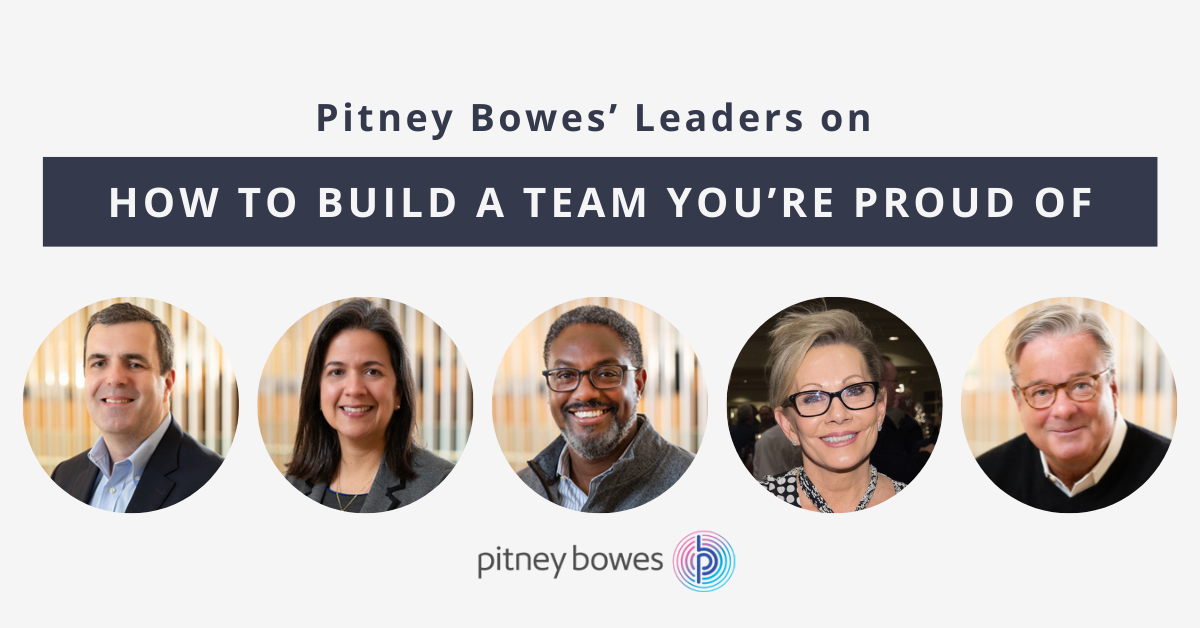There are countless books, podcasts, and articles on leadership. But nothing can quite describe the sense of pride a leader feels when they watch a team they’ve built succeed.
That feeling of pride resonates and inspires others to continue to work hard, achieve more, and build on their strengths. We sat down with some leaders at Pitney Bowes to hear how they’ve been able to build teams they’re proud of. Read on for their stories and advice.
Value Unique Perspectives and Experiences
To build a successful team, it’s crucial to focus on the skills, perspectives, and experiences that each individual team member brings to the table. “One skill that stands out above and beyond everything is that once you are in an executive role of any type, you are really a human resources leader. Many people don't understand the amount of time that is spent on the people side of the equation with our most precious resource, talent,” says Pitney Bowes Chief Financial Officer, Ana Chadwick.
So, when you’re choosing people, Senior Vice President and President of Pitney Bowes Global Financial Services Christopher Johnson encourages leaders to fill the team with as many diverse perspectives as possible. “Diversity in business is about winning. It's about achieving success. The best performing companies are those that promote diversity and inclusion,” he elaborates. “Diversity gives us something that is important for our business: diversity of thought. Through our different lenses — whether you are a woman, from whatever race, religious background, belief, identity, or orientation — we can see opportunities and build on each other’s ideas. This lends itself to an environment where the best of the best ideas can be forged.”
Similarly, Executive Vice President and President of Sending Technology Solutions, Jason Dies keeps his eye out for people with unique backgrounds and talents. “I generally look for people with diversity in experience and perspectives,” he says. “For example, sales and marketing, or finance and supply chain. Even within your own part of the organization you can get different experiences that will allow you to look at things in a new way. Being ambidextrous — the ability to work on multiple goals at the same time — is important.”
But your team members aren’t the only source of unique perspectives that you can tap into. Ana encourages leaders to remember the role that mentors and sponsors can play, which is why she suggests they nurture their network. “When you find someone who's willing to stick their neck out for you and sponsor you, make sure you keep those relationships. It’s one thing to have someone sit at a distance and give you advice, but when you have someone who can say, ‘This person can do that, or is ready for that,’ treasure those sponsors. Keep in touch with them.”
Be Intentional About Your Leadership Strategy
Before you start building your team, you have to hone in on your leadership skills and work to embody them in your personal and professional life. Ana stresses that leadership extends far beyond the office. “You [can be a] leader at any stage or in any role. I look at kids, and they can be leaders in their own classrooms,” she elaborates.
Ana learned a lesson early in her career that has stuck with her as she’s grown into executive roles: the 3 ‘E’s of leadership. “As a leader, you have to have energy and you need to have the ability to energize others.” Then there’s edge. “You're not here to please everybody. You need to have a path and a mission, and you must have the edge to get there.” The last one is execution. “I've always been a firm believer of those ‘E’s: Your energy, energizing others, having edge, and execution, which you have to do with passion. Once that all comes together, a leader can set a vision, break down that vision into manageable tasks, and rally people around achieving those things.”
Bill Hughes, Chief Communications Officer, offers a different take on embodying leadership. When it comes to leadership styles, he prioritizes showing unwavering support to his team. “Somebody told me once that the best demonstration of leadership is how you bring people along with you, and whether or not they believe that you have their back,” he says. “That's true. When people know that we learn from mistakes, and we have each other’s backs, you have a much more efficient and productive team.”
These Pitney Bowes leaders break down some actionable ways to exercise those leadership skills and improve executive presence. President of Presort Services, Debbie Pfieffer urges new leaders to, “fill the space [they’re] in. You can’t be a quiet mouse in the corner. Don’t assume that others at the table have all the answers or more experience. Ask questions, lean into conversations. Be present and ask the questions that you know other people have, but that they’re afraid to ask.”
Jason reiterates the point that leaders shouldn’t be afraid to conscientiously take up space. His top tip for exuding a confident leadership style is to be prepared. “One trick to remember is that most times when you are presenting, you actually know more about the topic than the people you're presenting to. But on the flip side of that, be cognizant of your audience; you don’t want to overwhelm them by demonstrating everything you know about a topic,” he says. “When I give a presentation, I think of it as a story; it's not a set of individual charts or facts that I'm going to recite, but it's about moving the audience from point A to point B.”
Set Goals and Empower Your Team
Once you have established your team and a leadership strategy to support them, creating clear objectives to ensure they’re on the right track is the final step. Setting goals and working strategically is natural for many leaders, but oftentimes that involves getting out of your comfort zone. Take it from Christopher, a first-generation American. “I come from humble beginnings. What my family has achieved has been through a lot of hard work and sharing our experiences. To get the right set of experiences, you need to put yourself into positions that might sometimes be uncomfortable. As a Black man growing up in America, if I didn't get comfortable with the idea of being uncomfortable, I would not have been able to accomplish the things that I have. It's all about putting yourself into positions where you can learn.”
And don’t forget to celebrate your (and your team’s) success.
Christopher continues to give back to others, whether it's by sitting on local charity boards or empowering his team. “I get a great deal of joy helping people succeed — seeing how individuals on our team have been able to grow their careers, expand, learn, and develop.”
Bill agrees that empowerment is important to building and retaining a team you’re proud of.
“When you find great people, you want to do everything that you can to keep them. I try to reward people that are thinking differently. I think that's critical to success. Their success is your success.”




